Pull Up Bar
A pull up bar is one of the best exercise tools to build upper body strength, especially back, shoulders, and arms, and improve core strength.
Pull-ups are one of the most challenging and yet impressive feats of upper body strength of being able to lift your whole body weight off the ground until the top of your chest reaches the horizontal bar.
I have noticed that the ones who spend most of their time using a pull up bar as part of their workout routine have some of the best well-defined backs and abs as well as a good body posture.
There are many ways you can do pull-ups at home and many varieties of pull up bar systems available, such as bars that can be fixed to a solid structure or wall at home, doorway pull up bar system, and free-standing pull up bar system.
Pull up bar systems allow you to perform pull-ups, chin-ups, and hanging leg raises. They also allow you to attach resistance bands to the bar for assisted band pull-ups and other various resistance band exercises.
Considerations when choosing a pull up bar
I generally prefer a pull up bar attached or secured to a solid structure.
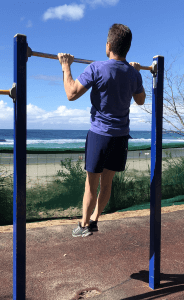
The wall-mounted system can be a good option. Still, it has you doing pull-ups too close to the wall, and because I like to straighten my legs when doing pull-ups, I find that my feet are constantly hitting the wall. Therefore, if the wall-mounted system is your only option, make sure that you choose one with the bar at least 60cm (24") away from the wall. This will provide you with enough room and allow you to do pull-ups facing away from the wall.
We like and recommend a pull up bar attached to two solid posts like you would find on exercise equipment at the park or a bar attached to the top of a power rack.
Choose a sturdy bar system with a solid construction, not one that bends or moves around a lot. You want a strong bar that can hold at least one and a half times your body weight.
Choose a bar with multiple grip options to get variety in your workouts.
If you want to avoid developing calluses on your hands, choose a bar with comfortable smooth or rubber-coated handgrips rather than a steel bar with knurling (a manufacturing process that creates angled or crossed lines into the surface).
Types of pull up bars
Straight bar
The straight bar is the most popular - a simple straight horizontal bar securely attached to a solid structure.
Multi-grip bar
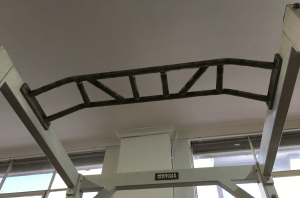
A multi-grip bar provides you with a variety of grip options. From narrow (neutral grip), angled grip to a wide grip. The various grip options allow you to work your back, shoulder, and arm muscles at different angles.
We have a multi-grip bar fixed to the top of our power rack. This makes it more versatile and allows you to perform various grip pull-ups and chin-ups.
Types of pull up bar systems
Doorway pull up bar
There are many doorways pull up bar systems on the market. These portable and affordable systems do not require permanent brackets or supports.
I have tried a few of these doorway systems, and they can be a good option as long as:
- You choose a solid construction system with a big weight capacity.
- You have an architrave and enough room around your door frame to accommodate the device.
- The construction of your door frame is strong enough to handle the device when performing a pull-up.
- You choose a multi-grip bar for workout variety.
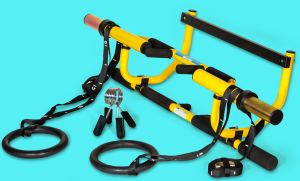
One particular bar that caught my attention is the Mega Bar by Gym Supreme. The Mega Bar looks robust, has a big weight capacity of 136kg (300lbs), and looks like a multi-functional device used for various applications.
Not only can it be used on your door frame for pull-ups, but you can attach gymnastic rings and straps to it for suspension training, and it can also be converted to a barbell.
Another doorway pull up bar system is the extended door frame pull up bar. It's a telescope type system that extends on either end to fit within the jambs of a doorway. Again, I would use brackets on either end to ensure it's fully secured to resist the user's load.
Wall or ceiling mounted system
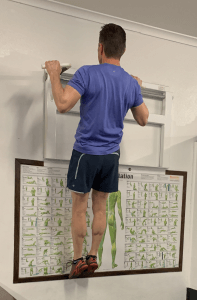
The advantage of this system is that it doesn't take up much space.
As mentioned above, make sure that you choose a wall-mounted system with a bar that's at least 60cm (24") away from the wall to give you plenty of room when performing exercises.
Some wall systems have brackets designed to be anchored to ceiling joists or beams. This would provide you with plenty of room around the bar, but it also depends on your height in relation to the ceiling height. If you are tall and have a low ceiling, there might not be enough vertical room to do pull-ups with a full range of motion. Although, some ceiling-mounted systems allow you to adjust the height of the bar on the brackets to accommodate for the height.
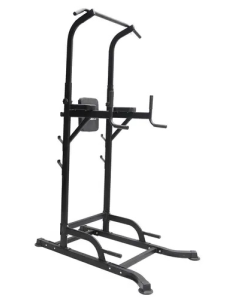
Free-standing system
If you don't want to put holes in the wall and want something portable, a free-standing system might be the way to go.
These systems also come with other attachments like a dip bar attachment.
The only drawback with these free-standing structures is that they can move around a little when doing pull-ups and take up valuable space at home.
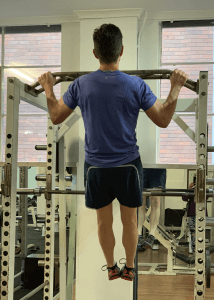
Power rack
Most power racks have a pull up bar or multi-grip bar attached at the top, which is solid and sturdy.
Improvised pull up systems
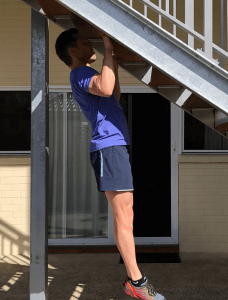
Improvised pull up systems are things such as a tree branch or the underside of a staircase. A word of caution, safety should be your number one priority as these things aren't as safe as using the right steel bar. I remember as a kid using a tree branch to try and do pull-ups. I suggest that if you are going to try using a tree branch that it's a solid tree with a sturdy branch and that you hold onto the branch close to the tree's trunk.
I occasionally use the underside of my outdoor steel staircase to challenge my grip on the wooden steps. I do these at my own risk and don't advise anyone to try this unless you're experienced at doing pull-ups.
Another way of doing pull-ups without using a bar and probably a safer option is to use gymnastic rings. However, there is always an element of instability and more challenging when using rings, especially when doing pull-ups.